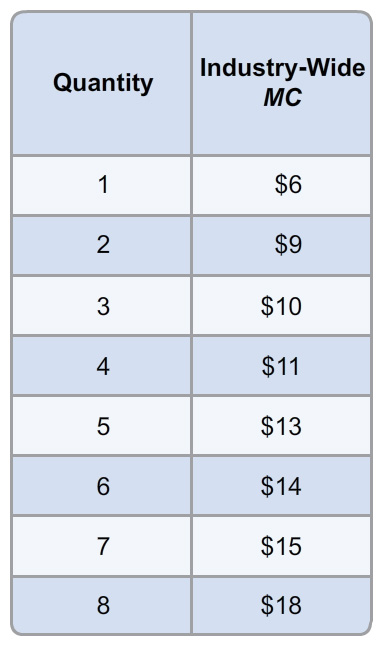Chapter 12. Chapter 12
Step 1
Question
Now let’s take a look at the equations for the marginal cost functions that are graphed in Thinking and Problem Solving Question 3, and see if we can combine them into one equation for industry-wide marginal cost. This is what the two equations for the graphs in the question look like:
MC1 = 2 + 4q1
MC2 = 7 + 2q2

Can you create an industry marginal cost equation that shows MCTotal as a function of qTotal instead of just q1 or q2?
First, solve both equations for q and fill in the missing information. (When you input your answers, round to two decimal places if needed. For example, if your number is .3490, enter .35; if 8, do not enter 8.00.)
q1 = O/5zOqbS1ag=MC1 − 9QTCBFxAkBk=q2 = 9QTCBFxAkBk=MC2 − brVrJl3J7nE=
Step 2
Question
Now, replace MC1 and MC2 with MCTotal, since Invisible Hand Principle 1 tells us that marginal cost will be equal for all of the firms in the industry. Next, write an equation for qTotal, which is just q1 + q2, by filling in the missing information. (When you input your answers, round to two decimal places if needed. For example, if your number is .3490, enter .35; if 8, do not enter 8.00.)
qTotal = G0+n1+REjHA=MCTotal − h4XZagboIgc=
Step 3
Question

Finally, solve the equation for MCTotal to create an industry marginal cost function from the cost functions of two different firms in the industry. You can check your work by plugging in quantities from the table (based on your answers for Thinking and Problem Solving Question 3) to see if the equation generates the same approximate number. Note that the equation assumes you can produce partial units at either firm, whereas your table was based on the assumption that only whole units were produced. Fill in the missing information:
MCTotal = [SLOPE]qTotal + [INTERCEPT]
MCTotal = FB:*1.33qTotal + xlSoIpNdi90=